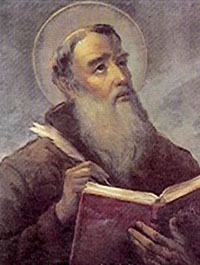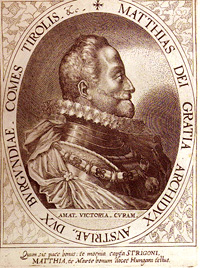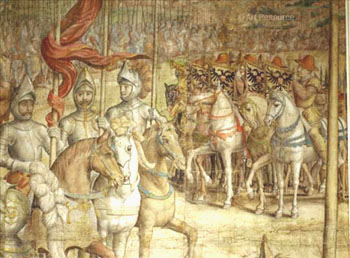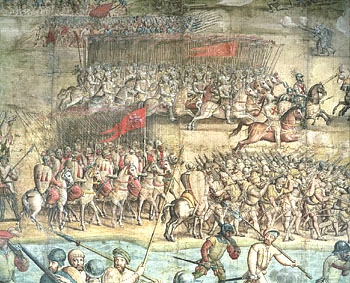 |
The Saint of the Day
St. Lawrence of Brindisi - July 22
Prof. Plinio Corrêa de Oliveira
Biographical selection:
Cesare de Rossi was born at Brindisi in the Kingdom of Naples on July 22, 1559 into a Venetian family of a good social standing. When sixteen, he entered the Capuchins, taking the name Lawrence. After studies in Verona, he was ordained and began to preach with great effect in Northern Italy. In 1596, he went to Rome as General of his Order, a position he would hold five times.

St. Lawrence of Brindisi
|
At the request of Emperor Rudolf II, who knew the reputation of the Capuchin, Pope Clement VIII sent Fr. Lawrence to Germany to help raise a crusade against the Turks. At that time, Mohamed III, the sultan of Constantinople, was advancing beyond the Danube with the aim of invading Hungary and Austria, thus opening the way to enter Italy. He bragged he would transform the altar of St. Peter's Basilica into a manger to feed the Turkish horses.
Emperor Rudolf had organized his army and invited all the German Princes to join him to defend Christendom. Fearing that this invitation would not be well received, he sent Fr. Lawrence to solicit assistance from the German Princes. The Capuchin was successful, and the help soon arrived. Archduke Matthias was chosen as the general of the Christian army. At his request, the Pope ordered Lawrence to join the army as its chaplain and adviser. He obeyed without hesitation.
When he arrived at the battle camp in October 1601, he found the army lined up in battle formation before him. The holy religious, a cross in his hand, addressed the soldiers and assured them a certain victory. Then, he prepared them for the combat by means of prayer and penance.

The Commander in Chief
|
On the day of battle, the Catholic General had only 18,000 men before the 80,000-strong army of the Turkish Sultan. Faced with this great disparity in numbers, the secondary commanders advised prudence and counseled the Archduke to withdraw. Archduke Matthias sent for Fr. Lawrence to ask his recommendation. The Capuchin advised attack, and for a second time, he assured a complete victory for the Catholic forces. His ardent faith wiped away the fear of the commanders. The decision was made to give battle, and the soldiers took their positions. Mounted, Lawrence addressed the troops and spoke with such vigor that the troops took the initiative and drove forward to attack the Turks with an incredible force.
The Turks resisted this first attack. Fr. Lawrence, who was riding in the first line of attack, continued to encourage and exhort the troops: “Advance! Advance! The victory is ours!” The soldiers charged again, and the enemies fell back in terror, fleeing in every direction. The Battle of Stuhlweissenburg took place on October 11, 1601. On the 14th of that same month, the Catholic forces engaged the Muslims in another battle and won a complete victory. The Turks withdrew their army behind the Danube after suffering a loss of around 30,000 men.
It is difficult to express the admiration Fr. Lawrence inspired among the commanders and soldiers. The Duke of Mercoeur, one of the commanders, declared that the holy religious had done more to win the war than all troops together, and that after the help of God and the Virgin Mary, it was to him that the two victories were owed. Once again Europe had been saved from the barbarian Muslims.
Comments of Prof. Plinio:
We can benefit from several different aspects of this selection.
First, it is interesting to note the contrast of personages when St. Lawrence preached to the nobles, inviting them to join the Crusade. On the one hand, we can imagine the nobles dressed in the grandiose court attire of that time, assembled in solemn halls. On the other hand, there is the Capuchin friar with a venerable beard who enters to preach, wearing his simple rough habit with sandals on his feet and a rope cord around his waist from which a Rosary hangs. In his hand is the thick walking stick of a pilgrim.

The cavalry with their armor, helmets adorned with feathers, shining swords, lances and shields...
|
He has nothing to impose himself on this noble audience except his Franciscan poverty. He addresses the greatest powers of Christendom without any human respect as the emissary of God and the Pope. He is so secure in his Capuchin vocation and of the necessity for the Crusade that he convinces most of the Princes to come to the aid of the Emperor.
Second, after this success, he is sent to join the army as chaplain and counselor. The scene of his arrival described above is magnificent. When he arrives at the field, the troops are assembled and standing at attention in battle form before him. We can imagine the different parts of an army of the time: the cavalry with their armor, helmets adorned with feathers, shining swords, lances and shields; the artillery with their many canons decorated with bronze-carved motifs common at that time; the infantry with thousands of soldiers lined up in battalions standing with their halberds, spears and muskets, the precursors of our carbines.
The whole army waits at attention to hear a simple Capuchin. He speaks, and his sermon has a profound effect on both the officers and soldiers. This picture reflects well for us the temporal splendor of the Constantine Church. We have lost even the memory of that splendor. This was, nonetheless, the typical earthly refulgence then of the glory of Our Lord Jesus Christ.

Inspired by St. Lawrence, the Catholic army makes the first charge against the Turks
|
Third, before the battle of Stuhlweissenburg (or Szekesfehevar = city of the royal pearl), we have the two sermons where unhesitatingly he encourages the army to kill the enemies of our Holy Religion. If all will enter battle with this holy intent, he guarantees the victory. There is no pacifism in the picture, only the exhortation to annihilate the Turks. Then, he prepared the army by means of prayer and penance, that is, he prepared the soldiers who were many fewer in number than the enemy to ask for Heaven’s help.
He gave the same encouragement to enter battle when Archduke Matthias asked St. Lawrence’s counsel. Again, in the name of God, he guaranteed the victory.
In his second sermon to the troops, he spoke with such energy that the soldiers did not wait to be attacked by the enemy, but charged forward against the Turks. We see that St. Lawrence raised in them a holy ire similar to that which Blessed Urban II and St. Bernard ignited in the knights of the first and second Crusades. We know the words of those sermons and how they inspired Catholics to bear every sacrifice for the glory of God. We do not know the precise words of St. Lawrence, but by the consequences we can well imagine the content.
Sermons delivered at crucial moments of great need like this one constitute the very heart of the Militant Church, so to speak. Later, after a sentimental piety entered the Church and encouraged a pacifist attitude toward the enemy, such sermons were called exaggerated and practically disappeared. Certainly no one hears sermons like this today. Instead, we hear many sermons preaching human prudence in face of danger and a false moderation toward the enemy. So long as this spirit reigns in the Church, defeat is certain. No one wins battles if he is not persuaded that he should annihilate the enemy of Our Lord Jesus Christ.

The Turks flee in panic after the vigorous attack of the Catholics
|
Fourth, another scene from this excerpt is that of St. Lawrence, mounted and in the first line of the battle, shouting to the troops: “Advance! Advance! The victory is ours!” What extraordinary courage this man had to ride against the enemies without any arms. What a magnificent portrayal of this Saint, exhorting the Catholic forces forward in the middle of the melée. It is not surprising that the warriors, taking up that attitude of the Saint, were filled with a celestial fervor for battle. Hence, they impetuously charged against the Turks, causing a great panic to rise in the Turks who fled the battlefield.
Fifth and the last point, we can well imagine what would have happened to Europe if this Battle of Stuhlweissenburg had been lost. The Turkish troops would have reached Budapest, Vienna, and then Rome. With the large number of Protestant insurrections that Europe was experiencing, the forces of Catholicism were exhausted. It would have been disastrous. The West was saved from Muslim domination by a man of God - St. Lawrence - who reignited the spirit of Crusade in those Catholic warriors.
Scripture has a very grave malediction against the man who will not fight: “Maledictus homo qui prohibet gladium suum a sanguine” [Cursed be he who withholds his sword from blood] (Jer 48:10). St. Lawrence of Brindisi was blessed because he did not fear to exhort 18,000 Catholic soldiers to face an army of 80,000 and make abundant Muslim blood be shed for the cause of the Church. We can admire the extraordinary results of his zeal.
Let us recommend ourselves to St. Lawrence of Brindisi, asking him to give us in our common, prosaic everyday life an admiration for this heroism, so that when the glorious events of the chastisement predicted by Our Lady in Fatima will take place, we will be prepared to follow the example he left for us. If we will be faithful to his preaching, we will see something that he did not see. St. Lawrence prevented the dusk of Christendom from falling; we will see the rising dawn of the Reign of Mary.


  | | Prof. Plinio Corrêa de Oliveira | |
The Saint of the Day features highlights from the lives of saints based on comments made by the late Prof. Plinio Corrêa de Oliveira. Following the example of St. John Bosco who used to make similar talks for the boys of his College, each evening it was Prof. Plinio’s custom to make a short commentary on the lives of the next day’s saint in a meeting for youth in order to encourage them in the practice of virtue and love for the Catholic Church. TIA thought that its readers could profit from these valuable commentaries.
The texts of both the biographical data and the comments come from personal notes taken by Atila S. Guimarães from 1964 to 1995. Given the fact that the source is a personal notebook, it is possible that at times the biographic notes transcribed here will not rigorously follow the original text read by Prof. Plinio. The commentaries have also been adapted and translated for TIA’s site.
|
Saint of the Day | Home | Books | CDs | Search | Contact Us | Donate

© 2002- Tradition in Action, Inc. All Rights Reserved
|
 |

|